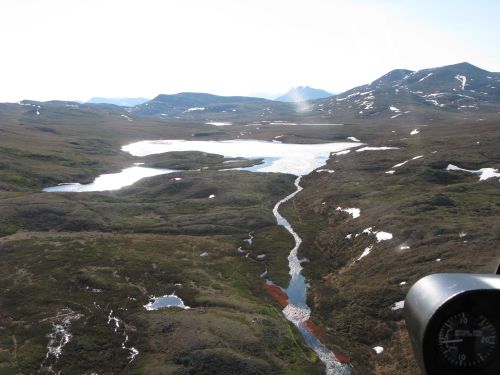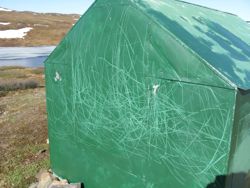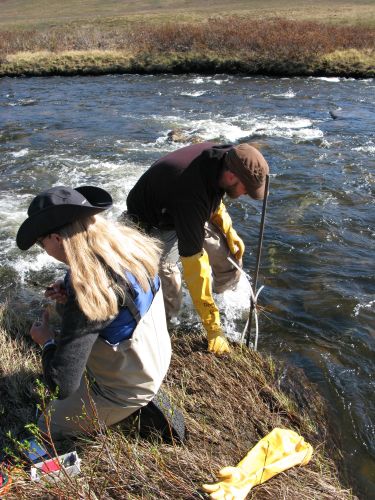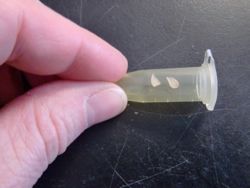Today’s Journal
Yesterday I spent the day riding on a helicopter!

I tagged along with Cameron Mackenzie and Heidi Golden who are part of the Fishscape project, which is a collaboration between the Marine Biological Lab at Woods Hole and University of Connecticut. They are studying the Arctic grayling (Thymallus arcticus) populations in a few of the rivers around Toolik and trying to get a sense of how these fish use the landscape. Cam is focusing more on the individual movement patterns of the fish, while Heidi is using fish genetics to look at landscape differences over longer timeframes. The Arctic grayling are an important link in the food chain of Arctic streams. They serve as food for other predators, such as lake trout, and control the stream insect population. Similar to the Bird seasonality project I talked about in an earlier post, the Fishscape project is looking at the impact of changing climate conditions on the Arctic grayling.
Many of the research teams require helicopter assistance due to the remote locations and the lack of roads. Cam and Heidi move throughout the river systems with their work and therefore require a helo to support some of their work.
Up to the headwaters
In the morning we flew up to the headwaters to pick up Heidi and Cam, who has been camping up there for about 3 weeks monitoring the fish in the lake (more about the fish in a minute). I was a little nervous at first, not really knowing what to expect on the helo, but my pilot made me feel very comfortable as he warmed up the helo. Then off we went! It was incredible to see the tundra from the air and to get a chance to see more the river valley where I have spend almost 5 weeks working.



Since Heidi and Cam were up at the lake for several weeks, they had a lot of gear that needed to be taken back to Toolik. The gear is put into a cargo net and then connected to the helo, which is called slinging.

Down the river valley

Next we flew down the Kuparuk to one of the fish antenna sites. Conveniently, we flew right over our water track sites, so I got to see how our sites fit into the over all landscape.



From the air, I was able to see that Arctic hillslopes are covered with water tracks. I am pretty amazed that more research has not been done on water tracks to this point and excited to be a part of this project to learn about storage and transport of nutrients in these water tracks.
Fish Monitoring
I mentioned that Cam and Heidi camped at the headwaters for about three weeks. The Arctic grayling are a migratory fish in that they overwinter in the headwaters lake and then move out of the lake to spawn as the ice melts and the lake temperature warms up. As the fish start to move out of the lake, Heidi and Cam PIT (Passive Integrated Transponder) tagged the fish. This process of inserting a PIT tag takes about three minutes and does not hurt the fish.

They have 10 PIT antennas throughout the Kuparuk River. When a fish swims past the antenna, the PIT tag transmits a unique signal that is recorded. This way they can get a sense of fish movement throughout the steam over the course of the year.


Cam has no fear about wading into the raging river. At times the water was about to overtop his waders. This year they installed the antennas earlier in the spring hoping to get more data about early fish movement. Unfortunately the ice in the river did a number on the antennas, so they had some maintenance to do.
Otoliths

Another really interesting part of their work involves removing and analyzing the ear bones or Otoliths of the fish, which help the fish with balance, orientation and detecting sound. They do harvest some fish, but these are different from the fish they are PIT tagging. Similar to tree rings, each year a fish puts on a new growth ring on their ear bones. The otoliths can be used to learn about the age and health of the fish and to compare water and bone chemistry to give them information about where the fish lived. Pretty fascinating, eh?
Helo Views
Check out my journal from May 21 to learn more about alfeis



Helo Video
I took a bunch of view from the helo, so once I have some time to edit it, I will post it here. http://youtu.be/esgo-FB26hk


Comments